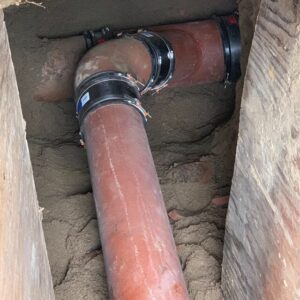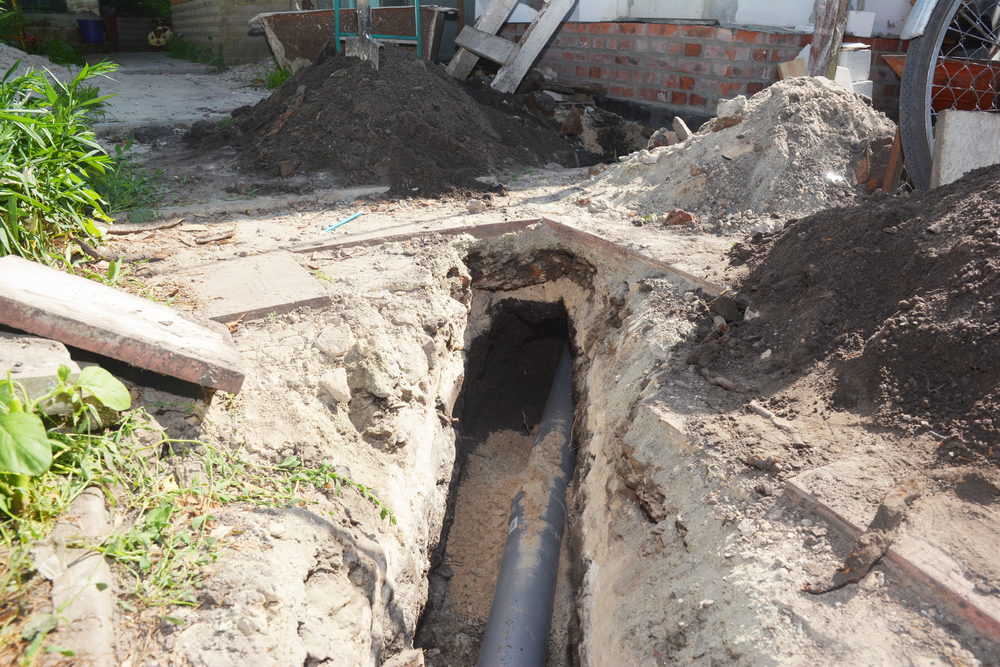Utilities, sewer line included, are things you have to connect to your residence or home. So are water lines and electrical service.
The question is, can you install a sewer line of your own?
In most cases, you’ll find sewer lines already stubbed to the curb, and all you need is to install your sewer line and connect it to the branch at your property line. If this is the case in your area, it’s a more straightforward affair.
This article answers what many people wonder—“Can I install my own sewer line?” We also talk about what you’re required to do and how to go about it.

Can I Install a Private Sewer Line?
Yes, you can install a sewer line. It’s allowed, and it’s something almost everyone can do.
There’s no doubt you must connect your new home to the sewer available in your area. After enquiring about its availability, the first step in installing a private sewer line is to make arrangements to connect your property, building, or home to the sewer branch at your property line.
You can call Blue Stakes to mark the utility locations on the ground so that as you dig the sewer line trench, you do it in the right direction towards the curb.
Local Codes of Authority Vary and Must Be Adhered To
Every city, county, town, or village has local codes that you must follow. You don’t want to incur such a considerable expense installing an illegal home sewer.
It’s advisable to hire sewer contractors who understand these local codes and ensure they’re licensed. Always remember that what’s allowed in your jurisdiction is likely not permitted in another.
For instance, NYC doesn’t allow plastic piping for a house sewer line while Nassau County permits it.
You Must Adhere to Your Local Inspection Requirements
Like local codes, sewer inspection requirements vary. Surprisingly, there are areas where you may not even require an inspection for particular sewer work.
The responsibility of the sewer owner also varies from one area to another.
For example, in most areas, you’re responsible for the entire length of your home sewer up to the connection point. On the other hand, there are areas you’re limited to your property boundary or the curb line.
Since sewer work requires a permit, an on-site inspection is mandatory. The relevant inspectorate in your county or town also ensures the job site is safe and that you use suitable materials and proper pipe pitches.
Steps to Install Your Own Sewer Line
Installing a private sewer line is a process. You’ll have to follow several steps to do it the right way. Besides, the local code of authority must govern all the installation details and approval given through one or several inspections.
Below are the steps to follow when installing your sewer line:
1. Map the Sewer Line Route
Before mapping out your sewer lines routes, you should first invite your local utility company to check for any underground hazards. That way, you establish the safest route to install your sewer line. It also makes it easier to plan the materials you need for the installation.
Depending on your pipes’ route, you may have to install several T-sections or elbows.
2. Determine the Elevations
After mapping the sewer line route, the next step is to determine the depth or elevation of each pipe end and how far the pipe needs to run.
In this case, you’re installing a residential sewer pipe, meaning it starts from where your property’s main drain exits your home foundation. From that point, the sewer line should slope downhill until it connects to the primary or city branch (a tap).
You can measure and layout elevations using traditional surveying equipment, laser level, or GPS.
3. Calculate the Slope
The elevations and length of the pipe run are essential. They’re what you initially use to calculate the slope.
According to International Code Council, the formula for initial slope calculation is:
Starting elevation – ending elevation (total drop in elevation) / total run (length) = the slope
The minimum standard slope for a lateral is two percent in most areas. This is equivalent to two feet of drop every 100 feet of run. Although your actual slope can be a little steeper than the two percent target, it must meet your local code requirements.
A too steep slope causes liquids to move faster than solids. The result is clogging in your sewer pipe. Similarly, a too shallow slope doesn’t provide sufficient velocity for proper drainage.
4. Dig the Sewer Line Trench and Lay the Bed
When digging the trench for your home sewer line, you must be very careful. This is imperative to ensure you don’t disturb the soil unnecessarily. If the worst happens and you disturb any soil, ensure you compact it thoroughly to minimize settling.
It’s advisable to make your sewer line trench as narrow as possible. A small sewer line trench decreases soil disturbance, although a wider trench is necessary in some cases.
Remember, you must compact the bottom of the trench and ensure it’s smooth. It must also follow the desired grade. Often, people lay a bedding material, specifically sand. That way, the trench will continuously support the sewer pipe.
Because sand is much easier to slope than soil, it makes it more suitable. It allows you to fine-tune the grade before installing the pipe.
5. Lay Out/Install the Pipes
Once you’re sure the trench is okay, it’s time to start laying your sewer pipe, one section at a time. It’s best to work your way from the lower end of the pipe length up to a higher elevation.
Before making any permanent connections, ensure everything fits in place according to your plan.
Today, sewer pipe is made from PVC. Therefore, you require solvent glue or gasket fittings to join it. The standard pipe size for home lines is four inches. However, you must refer to your local code for the required pipe size and material.
Ensure the female (bell) end of every pipe section faces uphill. This minimizes the leak changes at the pipe joints.
When connecting the pipe to the city main, you must follow your city’s specifications. At your property end, most local codes require one, at most, two cleanouts. These provide access to the pipe for cleaning with a sewer auger or scoping.
6. Backfill the Sewer Line Trench
After installing your sewer line and passing your final inspection, it’s time to backfill the trench. This is the last step of your property sewer line installation.
Having plenty of traps in your sewer line is vital. They make it easy to remove any clogs or make repairs in the future.
Start with a sand layer to eliminate any voids around the sewer pipe and protect it when backfilling. Then, add soil in layers to fill the trench. Before adding the subsequent soil layer, ensure to compact each of them carefully to minimize settling later.
It’s good to install a warning tape once you have filled the trench with the first soil layer and compacted it. In fact, this is a requirement in most areas. The warning tape serves as an alert to crews of the sewer line’s presence. Thus, it prevents accidental damage during future excavations in your home area.

Why Do Sewer Lines Fail?
- Clogs – You should only flush waste and toilet paper down your toilets. Flushing things such as diapers, baby wipes, paper towels, etc., can clog up your sewer pipes and create buildups.
- Soil shifts – Things such as heavy rain, flooding, drought, freezing temperatures, and other environmental changes can cause the soil around your sewer lines to shift. This movement could crack or break your sewer lines.
- Tree roots – If tree roots find their way inside your sewer line using cracks or joints, they can clog up your pipes and slow down your drains.
- Older pipes – Homes built with older pipes such as terracotta and cast iron are reaching the end of their life-use.
When Do Sewer Lines Need To Be Replaced?
- Constant backups – If all of your toilets, showers, and sinks, seem to be backing up, it’s most likely because your sewer line is damaged and needs to be replaced. – Sewer odors – When a sewer line breaks under your yard or inside your home, it can begin to leak odors.
- Slow drains – If all of your fixtures drain slower than usual, there’s a chance your sewer line needs to be replaced.
- Wall damage – If a sewer line breaks inside your walls, it can cause your drywall to become moldy or damp. –
- Pests – If your sewer line is cracked or broken, pests can use the opening to enter your home and pop out through your toilets or drains. –
- Yard growth and potholes – When a sewer line breaks underneath your yard, it can leak waste into your soil. Waste will act as a fertilizer and cause your grass to grow more than usual. Also, if waste leaks into your yard, this can cause the soil on your property to shift and allow dirt to settle, forming potholes.